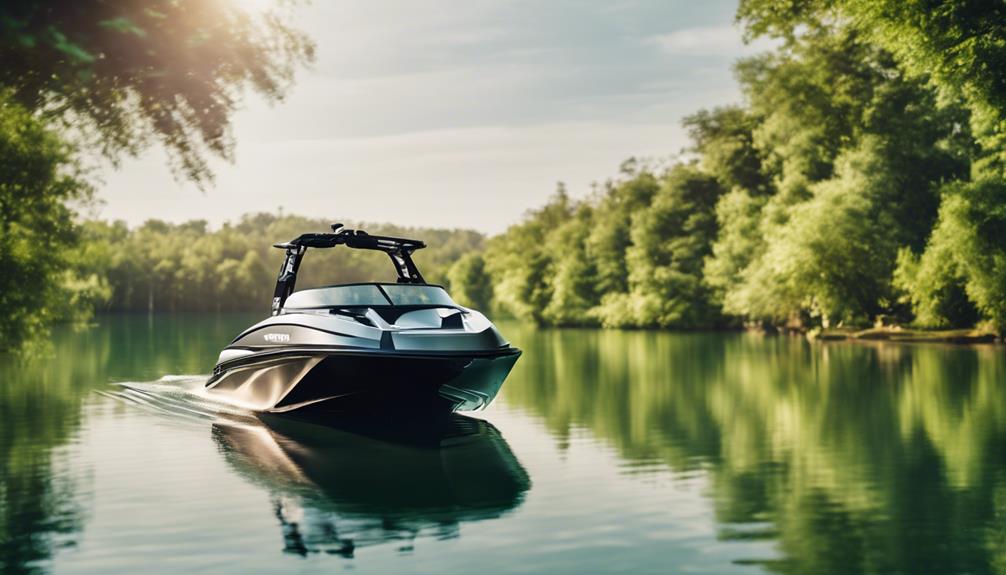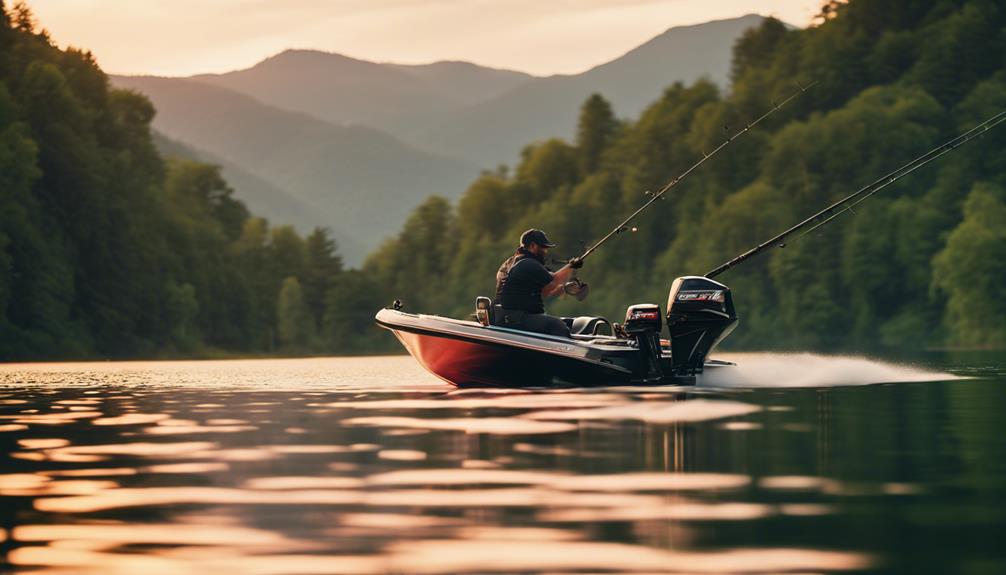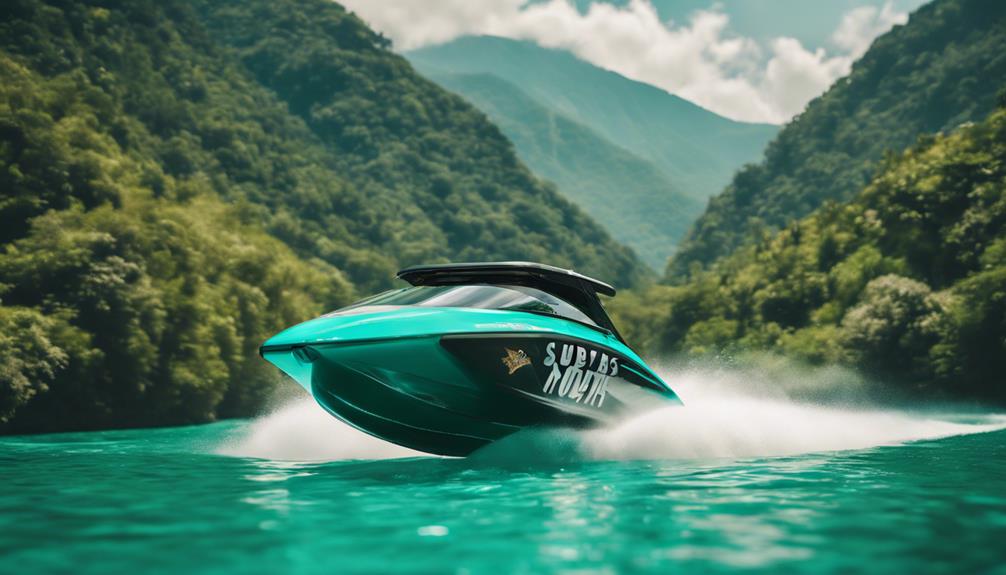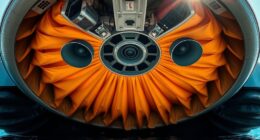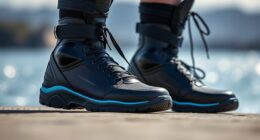Yamaha jet boats typically weigh between 2,370 lbs and 2,850 lbs, depending on the model you choose. For instance, the SX190 is on the lighter side at 2,370 lbs, while the 195S reaches a dry weight of 2,850 lbs, combining performance and style. The dry weight is essential for towing calculations and affects performance, fuel efficiency, and stability on the water. Understanding these weights can help you make an informed decision. If you're curious about how these weights impact specific models or towing capacities, you'll find plenty more information on that.
Key Takeaways
- Yamaha jet boats vary in weight: 19-foot models range from 2,370 lbs to 2,850 lbs, while 22-foot and 25-foot models are slightly heavier.
- The SX190 has a dry weight of 2,370 lbs, making it lightweight and agile for easy towing.
- The AR195 model offers enhanced performance with a dry weight of 2,600 lbs, balancing speed and stability.
- Weight affects performance: lighter boats enhance maneuverability and fuel efficiency during operation.
Overview of Yamaha Jet Boats
Yamaha jet boats offer a thrilling blend of performance and stability, making them ideal for both leisurely outings and exciting watersports. These boats, like the popular SX190, are designed to provide you with an enjoyable experience on the water.
With a dry weight of 2,370 lbs, the SX190 is manageable for towing, ensuring you can transport it easily to your favorite water spots. When you consider the trailer weight, which is around 3,047 lbs, you'll find that this combination of weight is well-balanced for stability while maneuvering through various water conditions.
Larger models, such as the AR220, boast enhanced build quality and may vary in weight, but they still prioritize performance, making them suitable for both recreational use and adrenaline-pumping activities.
Yamaha jet boats are engineered to maximize your time on the water. Their design supports smooth handling and quick acceleration, ensuring you can enjoy everything from calm family outings to thrilling watersports.
Weight Specifications by Model

When considering Yamaha jet boats, it's important to know the weight specifications for different models.
You'll find that the 19-foot models offer a lighter and more agile option.
On the other hand, the 22-foot models provide a balance of performance and stability.
For those seeking larger capacities, the 25-foot models deliver enhanced features and power on the water.
19 FT Model Weight
The weight specifications of the FT models vary, with dry weights ranging from 2,370 LBS to 2,850 LBS. Understanding the dry weight is vital for boaters as it impacts performance, fuel efficiency, and towing capabilities.
Here's a quick overview of the dry weights of the FT models:
- SX190: 2,370 LBS
- AR190: 2,526 LBS
- SX195: 2,695 LBS
- AR195: 2,745 LBS
- 195S: 2,850 LBS
Each model comes with its own trailer weight, which is also important to take into account. For instance, while the SX190 has a trailer weight of 3,047 LBS, the 195S tops out at 3,650 LBS. Knowing both the dry weight and trailer weight helps you make informed decisions about towing and storage.
When you're choosing a Yamaha Jet Boat, reflect on how these weights can influence your experience on the water. Whether you opt for the lighter SX190 or the more substantial 195S, understanding these specifications will guarantee you pick the right fit for your adventures.
22 FT Model Weight
Understanding the weight specifications for each FT model helps you choose the right boat that fits your needs and performance expectations.
Let's break down the details for the popular Yamaha models: the SX190, AR190, SX195, AR195, and 195S.
The SX190 has a dry weight of 2,370 lbs and a trailer weight of 3,047 lbs, making it lightweight yet capable.
The AR190 weighs about 2,400 lbs when dry, with a trailer weight slightly higher, offering a bit more versatility.
If you're looking for something with a little more heft, the SX195 features a dry weight of 2,500 lbs, providing solid performance without sacrificing agility.
Moving up, the AR195 boasts a dry weight of 2,600 lbs, enhancing its performance capabilities for those who crave speed and power.
Finally, the 195S model weighs in at 2,700 lbs dry, combining stylish design with robust performance.
Knowing these weights will help you make an informed decision that aligns with your boating lifestyle.
25 FT Model Weight
Yamaha's FT models offer a range of weight specifications that cater to various boating preferences and performance needs. Understanding these weights helps you determine how manageable each model is for towing and how they fit your performance-oriented design requirements.
Here are the weight specifications for the FT models:
- SX190: With a dry weight of 2,370 lbs, this model is lightweight and easy to tow.
- SX195: This supercharged model weighs around 2,600 lbs, showcasing its performance-oriented design while remaining feasible for towing.
- 195S: Weighing about 2,650 lbs, it combines style with performance, making it a solid choice without notably increasing overall weight.
In addition, the AR190 closely matches the SX190's dry weight, ensuring it's also manageable for towing.
The AR195 shares the same dry weight as the SX195, reflecting its enhanced features while still being lightweight.
Whether you're looking for the agility of the SX190 or the performance of the SX195, these specifications help you make an informed decision on which FT model suits your needs best.
Factors Affecting Boat Weight
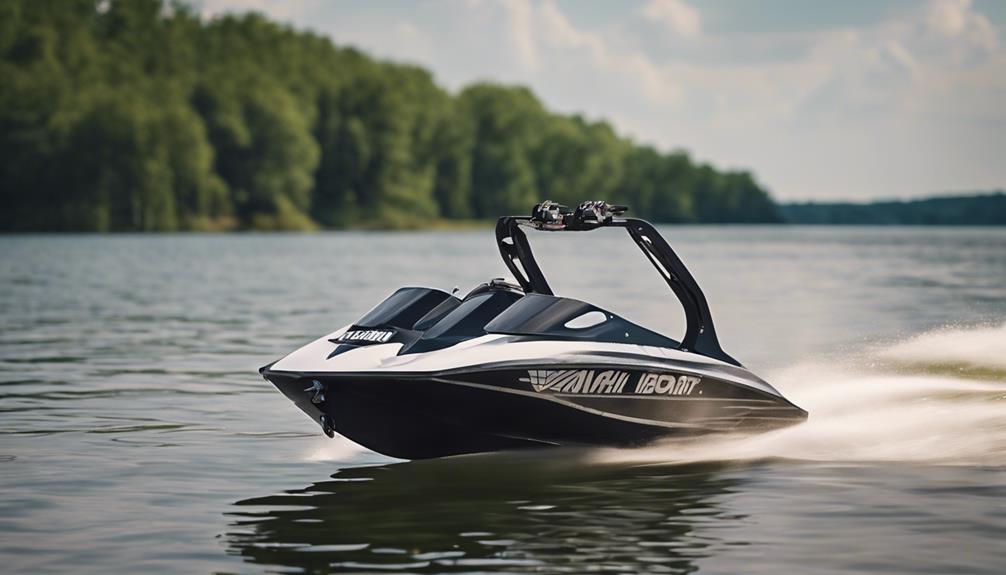
When you're considering a Yamaha jet boat, several factors can impact its weight.
The material composition, engine specifications, and any additional features all play a significant role in determining how heavy the boat will be.
Understanding these elements helps you make an informed decision for your boating needs.
Material Composition Impact
The materials used in a Yamaha jet boat's construction greatly influence its overall weight and performance. Your material choices can greatly impact the durability and handling of the boat. Understanding how these materials affect weight distribution will help you make informed decisions.
Here are three key factors to reflect on:
- Fiberglass: While it offers excellent durability and aesthetic appeal, high-quality gel-coated fiberglass can add substantial weight compared to other materials.
- Aluminum Components: Using lightweight aluminum in structural components can effectively reduce the overall weight without sacrificing strength or safety.
- Design Features: Variations in seating configurations and integrated storage solutions can alter weight distribution, affecting your boat's performance on the water.
Engine Specifications Influence
Engine specifications play a vital role in determining a jet boat's overall weight, impacting performance and handling on the water. For instance, the Yamaha Marine Engine in the SX190, with its 1.9 Liter High Output, considerably contributes to the boat's dry weight of 2,370 lbs. This weight is primarily influenced by the engine's size and the materials used in its components.
When you're evaluating total weight, it's important to take into account how these engine specifications interact with other factors. The presence of additional features, such as built-in storage compartments or specific seating arrangements, can also add to the total weight.
Moreover, if you're looking into weight evaluations, don't forget to factor in the trailer weight; the SX190's trailer alone weighs 3,047 lbs, which can be a considerable factor during transport.
Different models, like the SX195 and AR195, may have varied weights due to enhancements in engine performance and additional features. So, when reviewing a Yamaha jet boat, always pay attention to the engine specifications to get a clearer picture of its weight and performance capabilities.
Additional Features Weight
Additional features like built-in storage and seating configurations can considerably influence the overall weight of your Yamaha jet boat.
When you're evaluating the weight of a Yamaha jet boat, keep in mind that various aspects come into play, affecting not just weight but also performance and stability.
Here are three key factors to evaluate:
- High-Quality Materials: Using gel-coated fiberglass and other premium materials enhances durability and performance but can add weight.
- Storage Compartments: Extra storage options increase the boat's weight, so if you're planning on more compartments, factor that into your decision.
- Engine Types: Different engines have varying weights, which directly impacts the overall balance and stability of the boat.
Importance of Dry Weight
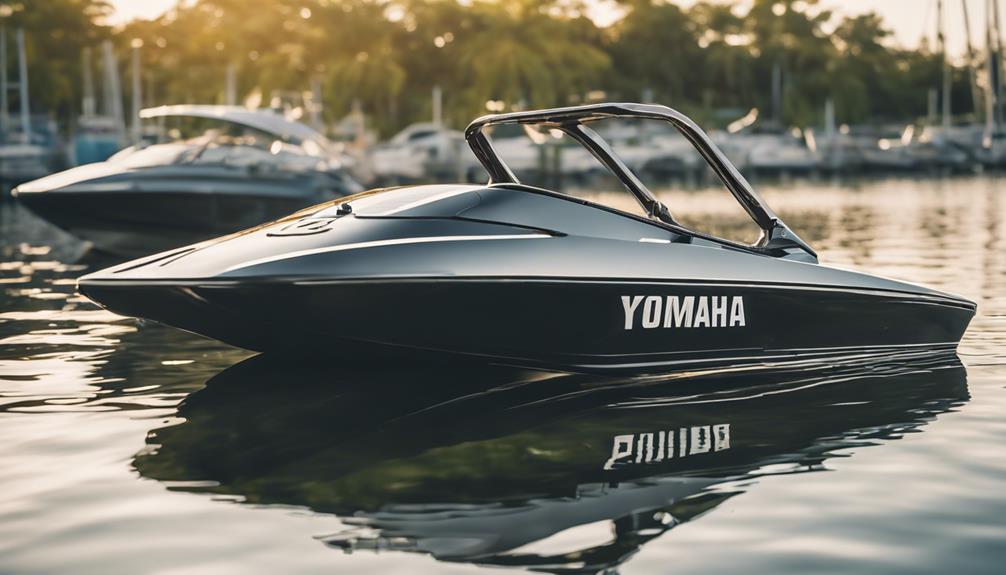
Understanding dry weight is important for any boat owner, as it directly impacts towing capacity, performance, and overall boating experience.
Dry weight refers to the weight of your Yamaha jet boat without any fluids, gear, or passengers, providing a baseline for performance calculations. For example, the Yamaha SX190 has a dry weight of 2,370 lbs, which is essential for determining your towing requirements.
Knowing this weight helps you choose the right trailer specifications and guarantees your vehicle has enough towing capacity for safe transportation. A lighter dry weight contributes to quicker acceleration and higher top speeds, enhancing your enjoyment on the water.
Moreover, understanding dry weight is significant for maintenance considerations. It affects how your boat sits in the water, influencing its stability during operation. Proper weight management can prevent issues that might arise from overloading, leading to a more pleasant and safe boating experience.
Performance Implications of Weight
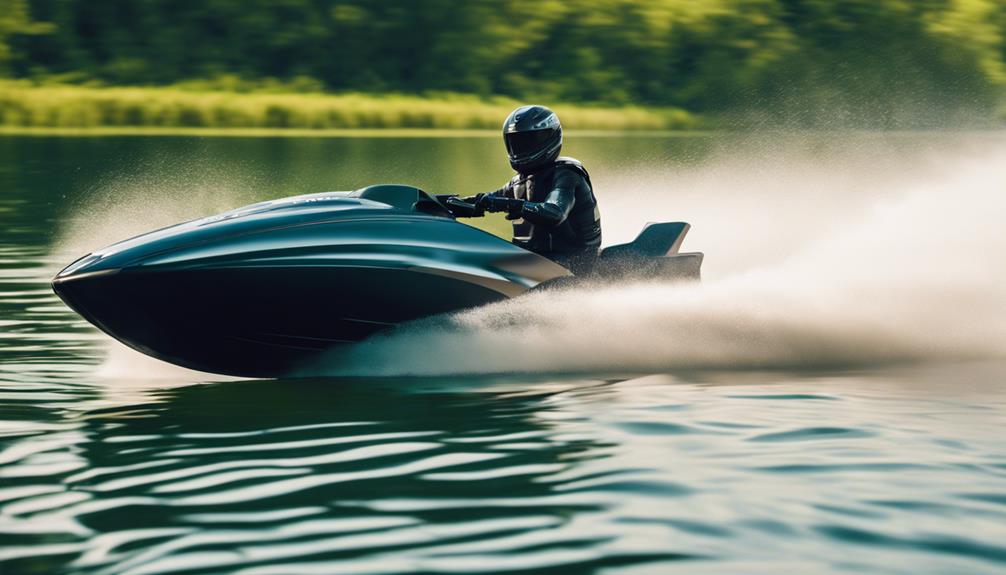
The weight of your Yamaha jet boat greatly affects its overall performance, influencing speed, agility, and fuel efficiency on the water. A lightweight design means quicker acceleration and higher top speeds, allowing you to enjoy thrilling rides.
Here are three key implications of weight on performance:
- Maneuverability: Lighter boats like the AR190 enhance responsiveness, making them perfect for watersports activities. You'll notice improved handling during sharp turns, which can elevate your overall experience.
- Fuel Efficiency: With reduced weight, Yamaha jet boats can achieve better fuel efficiency. This means you can spend more time on the water without the hassle of frequent refueling, giving you longer outings.
- Power-to-Weight Ratio: A better power-to-weight ratio optimizes engine performance. The lightweight construction of models like the SX195 allows for exhilarating acceleration and stability, ensuring you have a smooth ride even at high speeds.
Towing Considerations for Owners
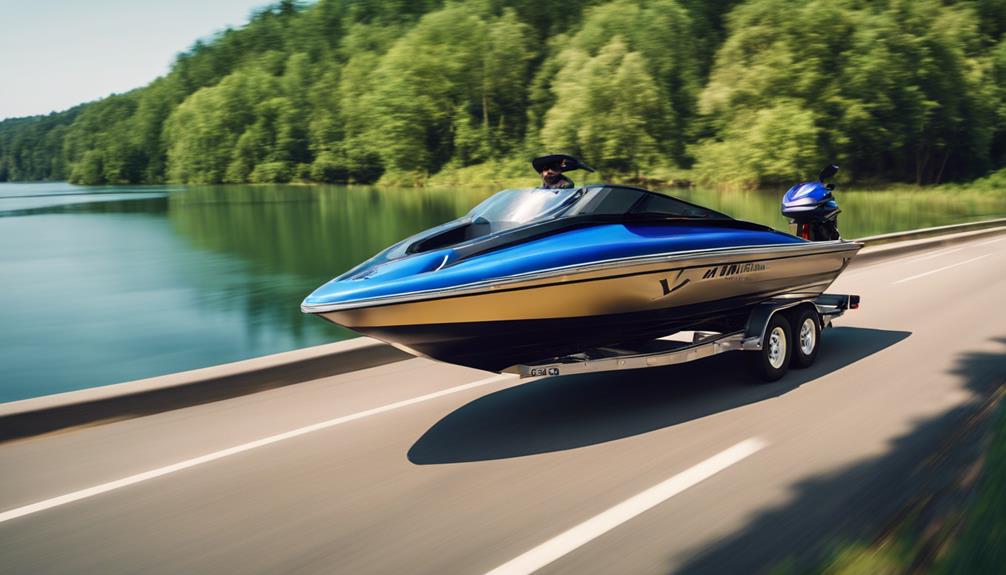
When enjoying the thrills of your Yamaha jet boat, it's essential to take into account towing requirements to guarantee a safe and efficient experience on the road.
First, you need to know the combined weight of your boat, trailer, and any additional gear or passengers. This total weight directly impacts your towing capacity and determines whether your tow vehicle can handle the load. Aim for a tow vehicle with a minimum towing capacity that exceeds this combined weight for peak performance.
Proper weight distribution on the trailer is critical for ensuring stability and handling during transport. An unbalanced load can lead to swaying or braking difficulties, so make sure to adjust your gear accordingly.
Additionally, consider parking considerations, especially with the SX190's trailer measuring 21 ft 2 in. Maneuvering such a length requires awareness of your surroundings and space.
Comparing Yamaha Models

Comparing various Yamaha jet boat models reveals significant differences in weight and design, impacting performance and handling on the water. If you're considering a Yamaha jet boat, here are some key differences to keep in mind:
- Yamaha SX190: This entry-level option has a dry weight of 2,370 lbs, making it easy to maneuver while providing tons of fun on the water.
- Yamaha SX195: Slightly larger than the SX190, this model boasts supercharged performance, though its specific weight details aren't provided. It's designed for those who want a bit more power in their ride.
- AR190 and AR220 Models: The AR190 features a similar weight specification to the SX190, emphasizing lightweight design for effortless handling. In contrast, the larger AR220 generally adds weight due to high-quality materials, offering a more luxurious experience.
When choosing between these models, consider how their weights and designs align with your performance needs.
Whether you prioritize lightweight handling or seek the supercharged performance of the SX195, Yamaha has a model to fit your boating lifestyle.
Additional Weight From Gear

Loading your Yamaha jet boat with gear can greatly increase its overall weight, affecting performance and handling on the water.
When you start adding accessories, the total weight can climb quickly. For instance, an empty Engel Cooler weighs about 12 lbs, but once you fill it with ice and drinks, that weight skyrockets, especially if you're retaining cold for days.
Don't forget about the Yamaha Boating Starter Kit, which adds around 15 lbs of essential safety gear. If you're planning a day out, a full tank of fuel contributes around 240 lbs, as the SX190 holds about 40 gallons, with each gallon weighing roughly 6 lbs.
Water recreation gear, like a Yamaha Floating Island, can also weigh around 25 lbs.
When you consider all these factors, the gear weight can greatly impact your boat's total weight. So, before you head out, think about what you're bringing along and how it might affect your jet boat's performance on the water.
Tips for Weight Management
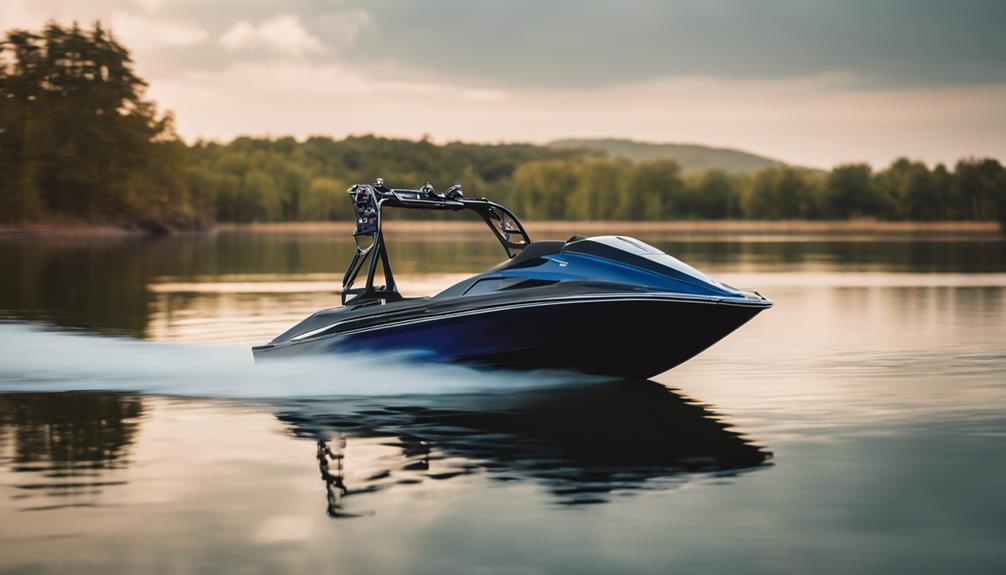
How can you effectively manage weight on your Yamaha jet boat to enhance performance and safety? Proper weight management is vital for the SX190 model, which has a dry weight of 2,370 lbs and a total trailer weight of around 3,047 lbs. Here are three tips to help you maintain ideal weight balance:
- Check Towing Capacity: Confirm your vehicle's towing capacity exceeds the total trailer weight to guarantee safe transportation. This is essential for hassle-free travel.
- Distribute Weight Evenly: Load your gear and additional accessories, like the Yamaha Boating Starter Kit, evenly across the boat. Uneven loading can compromise handling and stability, especially with a full crew of up to six passengers.
- Monitor Accessory Weight: Regularly assess the weight of any additional accessories you're bringing along. Avoid exceeding the boat's capacity to maintain safety and performance.
Frequently Asked Questions
How Much Does a Yamaha Jet Boat Weigh?
When you're considering a Yamaha jet boat, weights range from about 2,370 lbs for smaller models to 2,650 lbs for larger ones. Always check specific models for accurate dry and trailer weights before purchasing.
How Much Does a Yamaha Ls2000 Jet Boat Weigh?
Ever wondered how much a Yamaha LS2000 jet boat weighs? It's around 2,900 pounds dry. This lightweight design guarantees you enjoy a spacious 20-foot layout while balancing performance and comfort for up to 8 passengers.
How Much Does a 19 Foot Jet Boat Weigh?
A 19-foot jet boat typically weighs around 2,370 pounds dry. When you add the trailer, the total weight rises to about 3,047 pounds, making it easier for you to tow and maneuver.
How Much Does a Yamaha Sx190 Weight?
When you think of the Yamaha SX190, picture a nimble dancer gliding over the water. Weighing 2,370 pounds dry and about 3,047 pounds with the trailer, it's perfect for your next adventure.
Does the weight of a Yamaha jet boat affect its durability and lifespan?
When it comes to Yamaha jet boat durability facts, the weight of the boat can indeed have an impact on its lifespan. A heavier boat may experience more wear and tear on its engine and hull over time, potentially affecting its overall durability. It’s important to consider weight when assessing a jet boat’s longevity.
Conclusion
In summary, knowing the weight of your Yamaha jet boat is essential for performance and towing.
Did you know that some models can weigh as little as 2,200 pounds? This lightweight design not only enhances speed but also makes it easier to tow.
By managing your boat's weight effectively, you can guarantee a smoother ride and a more enjoyable experience on the water.
So, keep these factors in mind and make the most of your Yamaha adventure!

